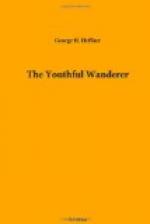A very high tower stands over the entrance door, at the west end of the church. The organ and choir (at the same end) rendered the finest music that I heard in England. There were several very highly cultivated voices among those of the half dozen ladies that occupied the space in front of the organ.
Everything else about the services is eminently examplery of the olden times. Preaching is the least important part of the exercises. Pulpit oratory finds no place here. Singing, praying and readings are the leading feature of worship in the English Church in general, and of old churches like this, in particular. Such exercises seem to be eminently appropriate for a people whose hearts and minds are almost petrified in civil and religious forms and ceremonies. The step which the English Church took away from Catholicism, must have been an extremely short one, if it was a step at all. This congregation still turn their faces toward the east, during a certain part of their recitals, and bow ceremoniously, in concert, as often, as they mention the name of “Jesus Christ.”
Two miles from Warwich, is Leamington, (L[)e]m’ington), a fashionable “spa,” which I visited in the afternoon. It is a very pretty town, and emphatically modern in style; presenting nothing that is anti-American in appearance, except its clusters of chimney-tops, so common everywhere in Europe. As soon as one has crossed the Atlantic he will seldom longer see single square tops built upon the chimneys, but each apartment of the house has its own chimney; all these converge, but do not meet before coming out of the roof, so that from two to six or eight tops generally keep each other company on the house-tops.
At 3:45 p.m., I started from Warwick for Coventry. The road leading from this place to Coventry is an excellent turnpike, just as that is from Stratford hither, and has a splendid gravel walk for pedestrians on one side, and a riding path for those on horseback, on the other side.
Five miles brought me to Kenilworth Castle. Great must have been its glories when Elizabeth came here in 1575 to visit Liecester. Cromwell dismantled it, and laid waste the gardens around it, and the tooth of time has been gnawing at it ever since, but it is magnificent even in its ruins. “Go round about it, tell the towers thereof, and mark well its bulwarks, if you would know what a mighty fortress it must have been when it held out for half a year against Henry III. in 1266, or what a lordly palace when it thrice welcomed Elizabeth to its hospitalities, three hundred years later.”
A quarter or half a mile further on, is a fine church, and nearby an ivy-covered arch. A passing gentleman told me this had been the entrance to an ancient abbey; and others said it was a part of the ruined Castle of Kenilworth.
It was 6:00 o’clock when I left here, and had five miles more to Coventry. A mile and a half on this side of that city lie the extensive possessions of Lord Leigh. This wealthy peer owns here, in one stretch, about twenty square miles of the finest and most fertile land in the world.




